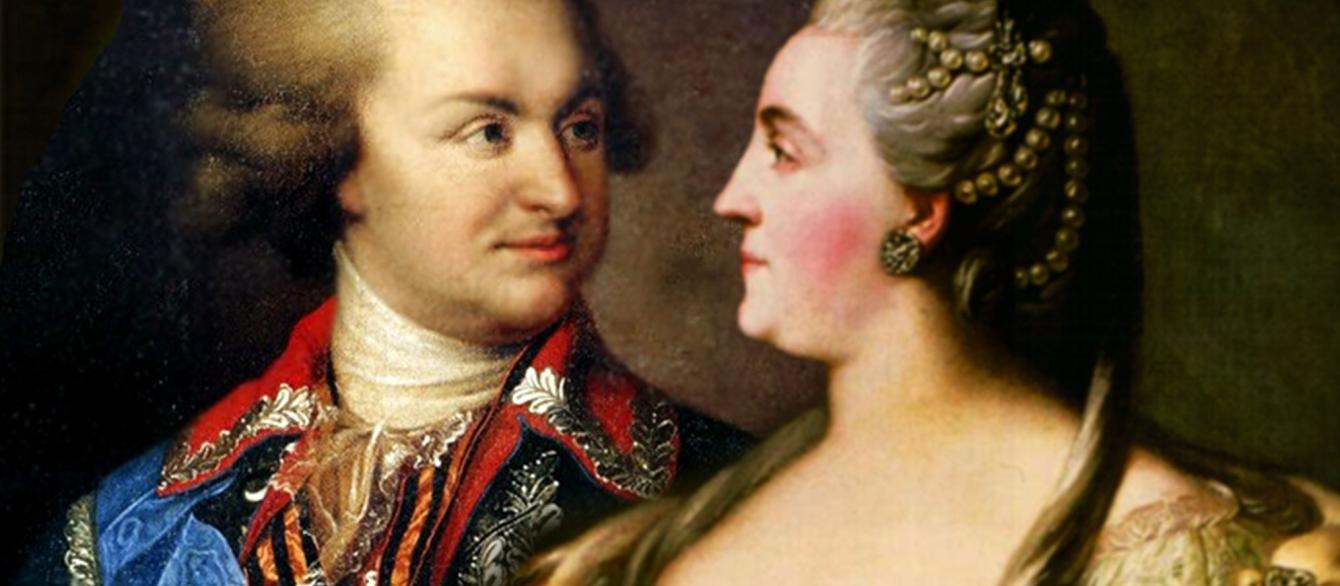Catherine the Great was a graphomaniac. Everyone who knew her knew this.
On winter mornings she rose at six o’clock and spent three hours in her study, writing. She wrote plays and drafted laws. She was a queen of marginalia, annotating works by Montesquieu and William Blackstone and Nikolai Novikov. Can't you see her, perched at a small-but-exquisite desk, near a window looking out on a frozen garden, her hair swept aside, intent on her work? The woman who ruled most of a continent must have relished having those hours to herself.
The Oxford English Dictionary assures us that graphomania is exactly what it sounds like: “a mania for writing.” The notion is distinctly modern. In fact, the first known use of the term in English dates to 1827 – three decades after Catherine’s death. By the end of the nineteenth century, graphomaniac had come to describe an individual who wrote incessantly but selfishly, detailing nothing but his or her mental or moral ailments. In the 1890s Max Nordau (Zionist leader and social critic) famously wielded the term as a weapon against those he accused of practicing “degenerate art” – men such as Oscar Wilde and Richard Wagner. William Jennings Bryan, a candidate for the U. S. Presidency in 1896, was accused of graphomania on the pages of the New York Times. According to the rather acerbic letter writer, Bryan's supposed condition created “the impression of a mind confused by problems too deep to be understood or presented by him.”ALIENIST. (1896, Sep 27). BRYAN'S MENTAL CONDITION. New York Times (1857-1922) Retrieved from http://search.proquest.com.ezp-prod1.hul.harvard.edu/historical-newspapers/bryans-mental-condition/docview/1016133744/se-2?accountid=11311 And Bryan wasn't the only one. Interestingly enough, presidential history is full of extreme writers. Barack Obama, for example, is a serial memoirist. And Donald Trump has been said to have “the most acute case of graphomania since John Quincy Adams and his unending diaries."Ganesh, J. (2021, Mar 24). The radical unavailability of Biden. Financial Times Retrieved from http://search.proquest.com.ezp-prod1.hul.harvard.edu/newspapers/radical-unavailability-biden/docview/2516619952/se-2?accountid=11311
Whether they tweet or adopt a long form, obsessive writers are everywhere in government, producing ideas and turns of phrase regardless of who is listening.

But Catherine was no ordinary graphomaniac: she was an empress. And her reign was voluminous.
Catherine was in power for 34 years, from 1762 until 1796. In that time, she orchestrated the partitions of Poland and annexed the Khanate of Crimea. She conjured towns, championed inoculation against disease, won wars, and put down the most spectacular uprising Russia would see until the twentieth century. But much of her most lasting work occurred on paper. She commissioned a survey of every nook and cranny of her territory. She issued a dizzyingly comprehensive set of administrative reforms. She published charters describing new documentary regimes that would govern access to social status and political power for the next century.
As a result, the written output of her tenure was astonishing. Over the course of his 43-year reign, Tsar Peter I – the other “Great” of the eighteenth century – issued an average of 87 decrees per year; over the course of hers, Catherine issued an average of 176. The content of the law code generated during her reign comes to an average of 250 pages per year, while the volumes containing the work of Peter’s reign average 97. Is this an almost obscenely rough method of approximating the scale of Catherine’s obsession with writing? It is. But the numbers suggest that the men who operated Catherine’s empire spent untold hours putting pen to paper, laboring over language. Writing, at least in part, as a result of their sovereign's graphomania.
Catherine’s own words are another story. She thought through writing. She wrote with intensity and astounding precision, articulating the high principles and prescribing the minutia of her realm. Wondering where to place the water glass in a hospital room? Catherine wrote about that. Curious where Russia stood on capital punishment? Catherine wrote about that.
We should be satisfied with what we have: an archive of passion and a masterclass in negotiation.
She loved through writing as well.
The great love of her life was Grigory Potemkin. Their relationship began when Catherine was forty-four and, though it evolved over the years, it truly ended only with Potemkin’s death in 1791. Their personal correspondence is one of the most valuable sources of the eighteenth century, running to 1,162 notes and letters. Given what we know of Catherine’s practice of burning letters she received from Potemkin (and others), there might not be much more to uncover. But we should be satisfied with what we have: an archive of passion and a masterclass in negotiation.
Catherine and Potemkin were well-matched. Their relationship proved to have staying power but it was tumultuous, especially in the early years. Catherine was arguably the most powerful woman in the world when she fell in love with Potemkin. She was middle-aged. She knew her own mind. She was formidable in many ways, and vulnerable in many others. Because of that, at times we see her write with wild abandon. At others, she writes with the terse wit of Emily Dickinson. She beseeches, she reproaches, she teases, she proclaims her devotion. She reminds Grigory that she is not someone to be trifled with and in the next breath uses the act of writing as an act of confession.
On February 4, 1774, Catherine and Potemkin spent their first hours alone together at Tsarskoe Selo, the imperial palace just outside St. Petersburg. Had they lived in England, the couple would have been just over a week shy of the annual celebration of the feast of St. Valentine on February 14. (In the Orthodox calendar, the feast of St. Valentine falls in July.) The feast was an old one, celebrated since the year 496 AD, but it was only in the eighteenth-century that the English began inventing the traditions that tied declarations of love to the day. Hundreds of years later here we are, dashing out to buy chocolates and roses and sitting down to write – yes, to write – to those we love.
If you are struggling to come up with the right words to express your feelings, consider mining the correspondence of the woman they call The Great.

Let's start with terms of endearment.
*All translations below are drawn from Douglas Smith's beautiful edition of the correspondence, Love and Conquest (Northern Illinois University Press, 2005).
Catherine often opened with a tried-and-true “My darling” “My sweetheart” “My love” “My heart” or even “Dear husband.” But if you are feeling bold, consider selecting from her more unique collection of terms:
My precious Grishenko
(Especially useful for those writing to someone who is named Grigory and appreciates the Russian art of diminutives.)
Sir Yaik Cossack
(For those dealing with lovable rebels.)
Sweet Lordikins
(For those with a taste for the silly.)
Clever Adonis
(For those partial to Greek myths.)
You five French volumes in folio
(For literature majors.)
My sweet beauty to whom no King can compare
(For the hopelessly romantic. You know who you are.)

And then it’s on to the message itself.
Love is not smooth sailing, even for an empress. But you can put Catherine's sufferings, as well as her happiness, to good use.
Rather than create a sequence from sweet to sour (or the reverse), these excerpts are listed in the order in which they were written to Potemkin (from 1774 to 1776). They function as a thumbnail sketch of the early, and most passionate, stage of their love affair.
I often forget to tell you what I must and what I had planned to say, for when I see you, you occupy my entire mind, and so I write.
(For those overcome by love.)
You don’t hunger to see someone you don’t love.
(When you need to offer convincing assurance of someone's place in your heart, keep it short and sweet.)
It’s time to stop or I’ll scribble a complete sentimental metaphysics that will finally make you laugh.
(Best deployed in a coffee shop. After lots and lots of coffee.)
How bad it is for one with a mind to lose it! I want you to love me. I want to appear desirable to you. But I only show you madness and extreme weakness. Ugh, how bad it is to love so extraordinarily. It’s an illness, you know. I’m ill, only I don’t send for the chemist nor do I write long letters. If you want, I shall paraphrase this page for you in three words and cross out all the rest. Here it is: I love you.
(For the inveterate rambler.)
Oh, my darling, you should be ashamed. What need do you have of saying that he who takes your place hasn’t long to live? Does using fear to compel someone’s heart look like the right thing to do?... So cross out these lines and banish even the thought of this, for it’s nothing but nonsense.
(For when you are secretly pleased by a bout of jealousy.)
I so terribly want to quarrel with you. I came to wake you, and not only weren’t you asleep, you weren’t even in your room. So, I see sleep overcame you merely as an excuse to run from me.
(No, you shouldn't write this to your loved one. But the honesty is refreshing, isn't it?)
With you everything becomes easy; this is what it means to truly love.
(That's right, Catherine penned the quintessential eighteenth-century Hallmark card.)
You lie, precious darling. I’m not the haughty one, I’m not the unfriendly one, I was simply very engrossed in my project. Nevertheless, I love you very much.
(For when you are dashing home from the office empty handed but with the best intentions.)
Oh you, I shall punish you with a kiss straight on the lips for slandering me with the charge of haughtiness.
(This will come in handy whenever you find yourself accused of haughtiness.)
Giaour, Muscovite, Cossack, do you want to make up? Put out your hand if your rage has passed and a glimmer of love remains within you. If not, I shall send for your brother-in-law. Giaour, Cossack, Muscovite.
(There's nothing like a thinly-veiled threat to ensure compliance. What is it they say? All is fair in love and war?)
It’s been a hundred years since last I saw you.
(Pure romance. Catherine wrote this just hours after seeing Potemkin.)
For all my labors I have but one comfort. Amid many ingratitudes from everyone, your affection alone pleases me. If I could be caressed by it again, I should wish that you stood before me, but not at all in the form of an angry Pluto, but an ingratiating little idol.
(This could be useful for... encouraging a less confrontational attitude?)
Control your anger, you little idol. You’re spouting drivel. You’re not going to move to the Sech or to a monastery.
(If your loved one is brandishing empty threats about picking up and moving to Ukraine, this one's for you.)
Giaour, Muscovite, Yaik Cossack, Pugachev, turkey cock, peacock, exotic tom-cat, golden pheasant, tiger, lion in the reeds...
(Because sometimes flinging a string of exotic and bizarre insults at your lover makes you feel better.)
Precious darling, I took a cord with a stone and tied it around the necks of all our quarrels, and then I tossed it into a hole in the ice.
(For when you tire of arguing and want to end that cycle with style.)
Among Catherine’s letters, there is one dated to 1776 that captures the full spectrum of emotion and intellect that bound her to Potemkin:
My friend, you’re angry, you’re sulky with me, you say you’re vexed, and why? Because I wrote you a letter this morning devoid of all common sense. You returned this letter to me, I tore it to pieces in front of you and burned it the very next moment. What more satisfaction could you desire? Even the Church aspires to no more once a heretic has been burned. My note has been burned. You should not want to burn me too, yet if you continue being sulky with me, you will ruin all my merriment till this passes. Peace, my friend. I stretch out my hand to you, do you wish to take it?
Potemkin would eventually take her hand. He always did. The two were exchanging letters right up to his death on the steppe near Jassy. In those later years the empress addressed him as “My true friend, Prince Grigory Aleksandrovich” – gone were the days when he figured as her Adonis, but no matter. Together they had built an empire.
Graphomaniacs are everywhere in history. You will find them composing musings and letters and poems and treatises, writing in private and in public. And for every famous scribbler – for every Marcus Aurelius or Voltaire putting precious ink to parchment – there is an anonymous graphomaniac working on any surface they can access, from birchbark peelings to concrete walls or the digital spaces of social media. From time to time we might harbor suspicions about the morality of these obsessive writers. We might be unsure whether they – and their writings – are relatable, persuasive, disingenuous, or abhorrent.
But for now, here’s to Catherine and her archive of passion. Here’s to the language of love and affection. Here’s to the art of stretching out a hand in peace.







